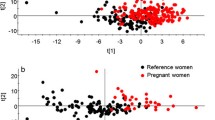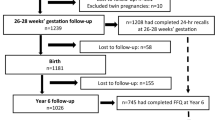Abstract
Background
Nutritional requirements increase during pregnancy. However, relatively few studies have examined longitudinal changes in dietary intake from periconception to pregnancy. Here, we investigated changes in the intake of food and nutrients, and compliance with dietary reference intakes (DRIs) in pregnant women.
Methods
The Japan Environment and Children’s Study, a nationwide multicenter prospective cohort study, included 30,373 pregnant women who answered a validated food frequency questionnaire repeatedly to assess changes in dietary intake in periconception and pregnancy. Energy-adjusted intakes of food groups and nutrients were described using the density method. The percentage of women not meeting DRIs was calculated.
Results
Of all foods groups examined, intake of food significantly increased from periconception to pregnancy for dairy products (mean difference 23.5 g/1000 kcal, 95% confidence interval [CI] 22.0–25.0 g/1000 kcal), confectionaries (2.0 g/1000 kcal, 1.8–2.2 g/1000 kcal), and soft drinks (1.3 g/1000 kcal, 0.3–2.3 g/1000 kcal). Of all nutrients examined, intake was significantly increased for calcium (mean difference 27 mg/1000 kcal, 95% CI 25–29 mg/1000 kcal), vitamin A (15 μgRE/1000 kcal, 13–18 g/1000 kcal), and saturated fat (0.4% energy, 0.4–0.4% energy). The percentage of women not meeting DRIs increased for vitamin B group, vitamin C, saturated fat and salt.
Conclusion
We found that energy-adjusted intakes of calcium, vitamin A, and saturated fat increased from periconception to pregnancy, while intake of other nutrients did not increase. The percentage of women not meeting DRIs increased for water-soluble vitamins, saturated fat, and salt.


Similar content being viewed by others
References
Abu-Saad, K., & Fraser, D. (2010). Maternal nutrition and birth outcomes. Epidemiologic Reviews,32(1), 5–25.
Barker, D. J. P. (1997). Maternal nutrition, fetal nutrition, and disease in later life. Nutrition,13, 807–813.
Blumfield, M. L., Hure, A. J., MacDonald-Wicks, L., Smith, R., & Collins, C. E. (2013). A systematic review and meta-analysis of micronutrient intakes during pregnancy in developed countries. Nutrition Reviews,71(2), 118–132.
Blumfield, M. L., Hure, A. J., Macdonald-Wicks, L. K., Patterson, A. J., Smith, R., & Collins, C. E. (2011). Disparities exist between National food group recommendations and the dietary intakes of women. BMC Women’s Health,11(1), 37.
Carriquiry, A. L. (1999). Assessing the prevalence of nutrient inadequacy. Public Health Nutrition,2(1), 23–33.
Craig, C. L., Marshall, A. L., Sjostrom, M., Bauman, A. E., Booth, M. L., Ainsworth, B. E., et al. (2003). International physical activity questionnaire: 12-country reliability and validity. Medicine and Science in Sports and Exercise,35(8), 1381–1395.
Cross, N. A., Hillman, L. S., Allen, S. H., Krause, G. F., & Vieira, N. E. (1995). Calcium homeostasis and bone metabolism during pregnancy, lactation, and postweaning: a longitudinal study. American Journal of Clinical Nutrition,61(3), 514–523.
De-Regil, L. M., Pena-Rosas, J. P., Fernandez-Gaxiola, A. C., & Rayco-Solon, P. (2015). Effects and safety of periconceptional oral folate supplementation for preventing birth defects. The Cochrane Database of Systematic Reviews,14(12), 7950.
dos Santos, Q., Sichieri, R., Marchioni, D. M. L., & Verly Junior, E. (2014). Brazilian pregnant and lactating women do not change their food intake to meet nutritional goals. BMC Pregnancy and Childbirth,14(1), 186.
Fowke, J. H., Schlundt, D., Gong, Y., **, F., Shu, X. O., Wen, W., et al. (2004). Impact of season of food frequency questionnaire administration on dietary reporting. Annals of Epidemiology,14(10), 778–785.
Haider, B. A., Olofin, I., Wang, M., Spiegelman, D., Ezzati, M., Fawzi, W. W., et al. (2013). Anaemia, prenatal iron use, and risk of adverse pregnancy outcomes: Systematic review and meta-analysis. BMJ,346, 3443.
Hure, A., Young, A., Smith, R., & Collins, C. (2009). Diet and pregnancy status in Australian women. Public Health Nutrition,12(6), 853–861.
Hyde, N. K., Brennan-Olsen, S. L., Bennett, K., Moloney, D. J., & Pasco, J. A. (2017). Maternal nutrition during pregnancy: Intake of nutrients important for bone health. Maternal and Child Health Journal,21(4), 845–851.
Institute of Medicine. (2006). Dietary Reference Intakes: The Essential Guide to Nutrient Requirements. Washington, DC: The National Academies Press.
IPAQ Group. (2015). Guidelines for data processing and analysis of the international physical activity questionnaire. Retrieved November 1, 2019, from http://www.ipaq.ki.se.
Jebeile, H., Mijatovic, J., Louie, J. C. Y., Prvan, T., & Brand-Miller, J. C. (2016). A systematic review and metaanalysis of energy intake and weight gain in pregnancy. American Journal of Obstetrics and Gynecology,214(4), 465–483.
Kawamoto, T., Nitta, H., Murata, K., Toda, E., Tsukamoto, N., Hasegawa, M., et al. (2014). Rationale and study design of the Japan environment and children’s study (JECS). BMC Public Health,14(1), 25.
Livingstone, M. B. E., & Black, A. E. (2003). Markers of the validity of reported energy intake. The Journal of Nutrition,133(3 Suppl), 895S–920S.
Lundqvist, A., Johansson, I., Wennberg, A., Hultdin, J., Högberg, U., Hamberg, K., et al. (2014). Reported dietary intake in early pregnant compared to non-pregnant women—A cross-sectional study. BMC Pregnancy and Childbirth,14(1), 373.
McGowan, C., & Mcauliffe, F. (2012). Maternal nutrient intakes and levels of energy underreporting during early pregnancy. European Journal of Clinical Nutrition,6615(10), 906–913.
Michikawa, T., Nitta, H., Nakayama, S. F., Ono, M., Yonemoto, J., Tamura, K., et al. (2018). Baseline profile of participants in the Japan Environment and Children’s Study (JECS). Journal of Epidemiology,28(2), 99–104.
Ministry of Health, Labour, and Welfare. (2013). Vital Statistics, 2013. Retrieved November 1, 2019, from http://www.mhlw.go.jp/toukei/saikin/hw/**kou/geppo/nengai11/kekka02.html.
Ministry of Health, Labour, and Welfare. (2015a). Dietary Reference Intakes for Japanese, 2015. Retrieved November 1, 2019, from http://www.mhlw.go.jp/stf/shingi/0000041824.html.
Ministry of Health, Labour, and Welfare. (2015b). National Health and Nutrition Examination Survey, 2015. Retrieved November 1, 2019, from https://www.mhlw.go.jp/bunya/kenkou/kenkou_eiyou_chousa.html.
Miyake, Y., Sasaki, S., Tanaka, K., Yokoyama, T., Ohya, Y., Fukushima, W., et al. (2006). Dietary folate and vitamins B12, B6, and B2 intake and the risk of postpartum depression in Japan: The Osaka Maternal and Child Health Study. Journal of Affective Disorders,96(1–2), 133–138.
Miyake, Y., Tanaka, K., Okubo, H., Sasaki, S., & Arakawa, M. (2013). Fish and fat intake and prevalence of depressive symptoms during pregnancy in Japan: Baseline data from the Kyushu Okinawa Maternal and Child Health Study. Journal of Psychiatric Research,47(5), 572–578.
Murphy, S. P., & Poos, M. I. (2002). Dietary Reference Intakes: summary of applications in dietary assessment. Public Health Nutrition,5(6a), 843–849.
Nowicki, E., Siega-Riz, A.-M., Herring, A., He, K., Stuebe, A., & Olshan, A. (2011). Predictors of measurement error in energy intake during pregnancy. American Journal of Epidemiology,173(5), 560–568.
Okubo, H., Miyake, Y., Sasaki, S., Tanaka, K., Murakami, K., & Hirota, Y. (2011). Nutritional adequacy of three dietary patterns defined by cluster analysis in 997 pregnant Japanese women: the Osaka Maternal and Child Health Study. Public Health Nutrition,14(4), 611–621.
Pinto, E., Barros, H., Dos, S. S. I., & Silva, S. (2009). Dietary intake and nutritional adequacy prior to conception and during pregnancy: A follow-up study in the north of Portugal. Public Health Nutrition,12(7), 922–931.
Ramage, S. M., McCargar, L. J., Berglund, C., Harber, V., Bell, R. C., Letourneau, N., et al. (2015). Assessment of pre-pregnancy dietary intake with a food frequency questionnaire in Alberta women. Nutrients,7(8), 6155–6166.
Rifas-Shiman, S. L., Rich-Edwards, J. W., Willett, W. C., Kleinman, K. P., Oken, E., & Gillman, M. W. (2006). Changes in dietary intake from the first to the second trimester of pregnancy. Paediatric and Perinatal Epidemiology,20(1), 35–42.
Ritchie, L. D., Fung, E. B., Halloran, B. P., Turnlund, J. R., Van Loan, M. D., Cann, C. E., et al. (1998). A longitudinal study of calcium homeostasis during human pregnancy and lactation and after resumption of menses. The American Journal of Clinical Nutrition,67(4), 693–701.
Science and Technology Agency. (2010). Standard tables of food composition in Japan (7th ed.). Tokyo: Printing Bureau of the Ministry of Finance.
Skreden, M., Bere, E., Sagedal, L. R., Vistad, I., & Overby, N. C. (2014). Changes in beverage consumption from pre-pregnancy to early pregnancy in the Norwegian Fit for Delivery study. Public Health Nutrition,18(7), 1187–1196.
Tsugane, S., Kobayashi, M., & Sasaki, S. (2003). Validity of the self-administered food frequency questionnaire used in the 5-year follow-up survey of the JPHC Study Cohort I: Comparison with dietary records for main nutrients. Journal of Epidemiology,13(1 Suppl), S51–S56.
Willett, W. C., Howe, G. R., & Kushi, L. H. (1997). Adjustment for total energy intake in epidemiologic studies. The American Journal of Clinical Nutrition,65(4 Suppl), 1220S–1228S. discussion 1229S–1231S.
Yokoyama, Y., Takachi, R., Ishihara, J., Ishii, Y., Sasazuki, S., Sawada, N., et al. (2016). Validity of short and long self-administered food frequency questionnaires in ranking dietary intake in middle-aged and elderly Japanese in the Japan Public Health Center-Based Prospective Study for the Next Generation (JPHC-NEXT) Protocol Area. Journal of Epidemiology,26(8), 420–432.
Acknowledgements
This work was funded by the Ministry of the Environment, Japan. Members of the Japan Environment and Children’s Study (JECS) as of 2017 (principal investigator, Toshihiro Kawamoto) were: Reiko Kishi (Hokkaido Regional Center for JECS, Hokkaido University, Sapporo, Japan); Nobuo Yaegashi (Miyagi Regional Center for JECS, Tohoku University, Sendai, Japan); Koichi Hashimoto (Fukushima Regional Center for JECS, Fukushima Medical University, Fukushima, Japan); Chisato Mori (Chiba Regional Center for JECS, Chiba University, Chiba, Japan); Shuichi Ito (Kanagawa Regional Center for JECS, Yokohama City University, Yokohama, Japan); Zentaro Yamagata (Koshin Regional Center for JECS, University of Yamanashi, Chuo, Japan); Hidekuni Inadera (Toyama Regional Center for JECS, University of Toyama, Toyama, Japan); Michihiro Kamijima (Aichi Regional Center for JECS, Nagoya City University, Nagoya, Japan); Toshio Heike (Kyoto Regional Center for JECS, Kyoto University, Kyoto, Japan); Hiroyasu Iso (Osaka Regional Center for JECS, Osaka University, Suita, Japan); Masayuki Shima (Hyogo Regional Center for JECS, Hyogo College of Medicine, Nishinomiya, Japan); Yasuaki Kawai (Tottori Regional Center for JECS, Tottori University, Yonago, Japan); Narufumi Suganuma (Kochi Regional Center for JECS, Kochi University, Nankoku, Japan); Koichi Kusuhara (Fukuoka Regional Center for JECS, University of Occupational and Environmental Health, Kitakyushu, Japan); and Takahiko Katoh (South Kyushu/Okinawa Regional Center for JECS, Kumamoto University, Kumamoto, Japan).
Author information
Authors and Affiliations
Consortia
Corresponding author
Ethics declarations
Conflict of interest
The authors declare no conflicts of interest.
Additional information
Publisher's Note
Springer Nature remains neutral with regard to jurisdictional claims in published maps and institutional affiliations.
The members of the Japan Environment and Children’s Study Group are listed in the acknowledgments.
Rights and permissions
About this article
Cite this article
Ishitsuka, K., Sasaki, S., Yamamoto-Hanada, K. et al. Changes in Dietary Intake in Pregnant Women from Periconception to Pregnancy in the Japan Environment and Children’s Study: A Nationwide Japanese Birth Cohort Study. Matern Child Health J 24, 389–400 (2020). https://doi.org/10.1007/s10995-019-02835-z
Published:
Issue Date:
DOI: https://doi.org/10.1007/s10995-019-02835-z




